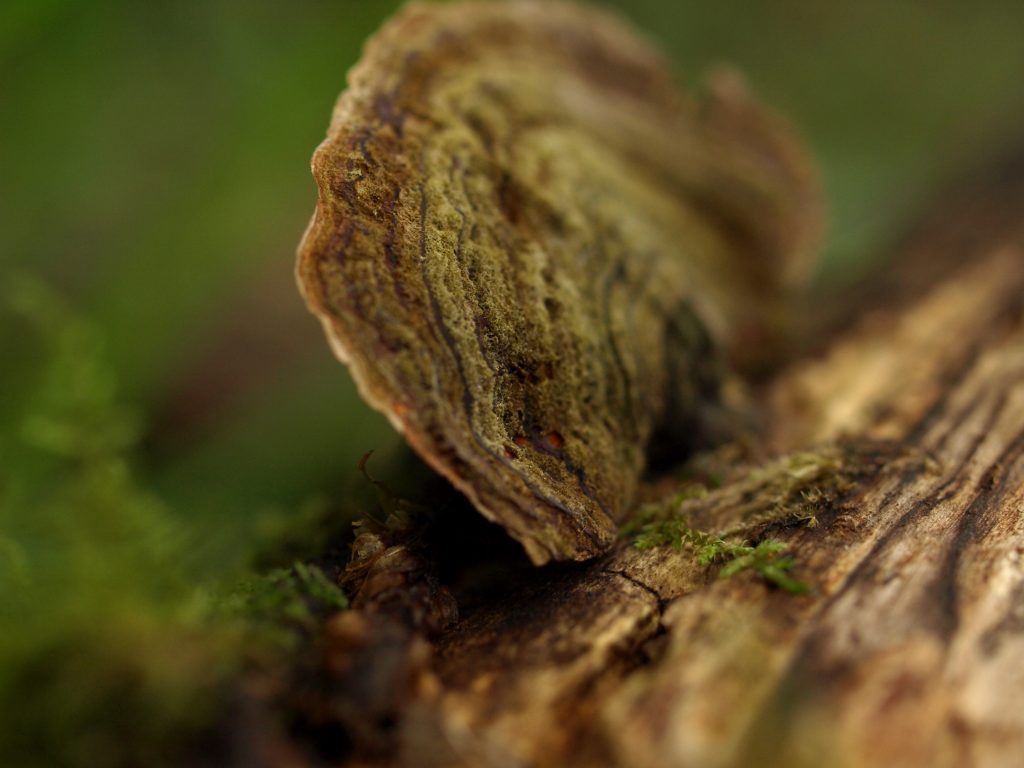Medicinal mushrooms are becoming more and more mainstream, in large part due to the growing popularity of companies like Four Sigmatic who make using mushrooms delicious and fun. But these fabulous fungi are far from new. In fact, mushrooms have been used in traditional medicine dating all the way back to at least 450 bce when Hippocrates classified the amadou mushroom as a potent anti-inflammatory1! There are so many options out there, all with their own uses and benefits, so it’s just a matter of doing a little reading and determining which may be a good fit for you before talking to your naturopath or conventional doctor.
In the next series of blog posts, I will be going into detail on the best medicinal mushrooms for cancer, their history, benefits for cancer, and how to best incorporate them into your protocol. There is much more to these toadstools than meets the eye, so let’s get into it by starting with the Coriolus versicolor mushroom!
*Note: Please keep in mind that I am not a doctor and you should not take the following information as a replacement for advice from a licensed professional. Always consult with a member of your healthcare team before starting any new supplements or natural compounds. The following information has not been evaluated by the FDA.

What the heck is a Coriolis?
More commonly known as turkey tail mushroom or Yun Zhi (cloud mushroom), this mushroom’s use in medicine originates in China, though you can find it all over the Northern hemisphere in Asia, Europe, and North America. It also grows pretty much all year, making it quite an accessible mushroom. You have likely come across it while hiking!
As you may have been able to guess from its common name, the turkey tail mushroom looks just like that, a turkey’s tail! It can range in colour from browns and reddish browns to greys and whites. They are quite beautiful, with concentric rings of colour and alternating areas of smooth and fuzzy textures, and they grow along dead tree trunks, overlapping almost like scales.
When it comes to their taste, Coriolus is quite mild, especially when compared to some of the other mushroom varieties we will be discussing. It has a light, mushroomy flavour, and most people can enjoy teas, broths, or the powder in smoothies without any trouble.

What’s their deal?
As mentioned above, the first recorded use of Coriolus mushrooms for healing was in China in 1368 AD where the Ming Dynasty would boil them into a tea for its health and energy-giving properties2. Their use has since spread all over the world, and their various benefits on physical health and healing have been widely studied. Current animal and human studies are very promising, though the gold-standard of double-blind studies are still needed.
Traditionally, this mushroom was used to give the consumer energy and to support their overall health, which now we can likely attribute to the immune-balancing effects of two of Coriolus’s compounds, polysaccharopeptide (PSP) and polysaccharopeptide Krestin (PSK).

Cancer Crusader
There are a number of benefits of the Coriolus mushroom that have been studied for cancer.
Enhancing the Immune System:
Coriolus versicolor has been shown to enhance the performance of the immune system by promoting the production of a number of cells that are key components of immunity. Studies have found that Coriolus induces the production of interleukin-6, interferons, immunoglobulin-G, macrophages, and T-lymphocytes, all important components of the immune system5. Studies report that the best effect of Coriolus on the immune system is that it “[…] has a potent effect on in vivo and in vitro expression of tumour necrosis factor (TNF)-α, commonly of interest for its ability to induce apoptosis and its potent tumouricidal activity”6. When human blood cells from healthy donors were incubated in PSP from Coriolus mushrooms for 18 hours, TNF-α secretion increased more than 3.5 times, and blood cells from breast cancer patients also exhibited increased TNF-α expression in response to PSP6. Coriolus has even been found to reduce the immunosuppression caused by tumours, thereby increasing your immune system’s ability to fight cancerous cells.
Anti-tumour Effects:
Coriolus has a number of tumouricidal effects, although it seems that some forms of cancerous tumours are more responsive in this regard to Coriolus mushroom PSP than others. Coriolus acts against tumours by interrupting their cell cycle, inducing apoptosis (programmed cell death), and by sensitizing them to various chemotherapeutic agents6. It is most effective against leukaemia, lymphoma, esophageal, colon, breast, gastric, liver, lung, and bladder cancers, but that doesn’t mean you can’t reap its other benefits!
Countering the Side Effects of Conventional Treatment:
Studies have suggested that Coriolus can help to improve some of the side effects associated with the conventional treatments of chemotherapy and radiation. Coriolus has been shown to improve appetite and liver function and also counter the immunosuppressive effects of these treatments6. Further, in a study with mice, Coriolus was shown to improve the animals’ recovery following gamma-radiation induced spleen damage6.
Antioxidative Effects:
Coriolus has been shown to promote the production of superoxide dismutase (a key antioxidant in healthy cells and a critical enzyme in the elimination of free radicals that cause cellular damage and mutations3) and glutathione peroxidase (an important antioxidant that scavenges free radicals4). This is also another way by which Coriolis slows the progression of various cancers5.

These fungi sound fantastic! But what do I even do with them?
There are a few different ways to use turkey tail mushrooms. Some are easier to incorporate than others, while some methods result in easier absorption. When it comes down to it though, you want to pick the method which will be the easiest for you to maintain; from my experience, no matter how good something is for you, if it is a hassle to do and not relatively easy to fit into your routine, eventually you will drop it.
Capsules:
This is probably the easiest method for the majority of people and the most popular. For turkey tail, the usual recommended dose can range from two 500mg capsules a day all the way up to six. This method is super easy to work into your routine, as many of us are already taking supplements and it doesn’t take much to add one more. The issue with capsules is that they can be difficult for your body to absorb, so if you know that you have trouble making proper use of supplements, you may be better off choosing one of the following options.
Powder in smoothies or broth:
If you already have smoothies in your diet, a great way to get your Coriolus in is to buy it in powder form and add a teaspoon to your smoothie. Unlike some of the other mushrooms I will be talking about later, turkey tail is relatively mild when it comes to taste, so the other ingredients in the smoothie will likely cover much of the taste. Although this is a convenient option for those making smoothies anyway and a fine choice if it is the easiest for you to maintain, smoothies do tend to be cold and mushrooms are better absorbed when they are warm. “[…] medicinal mushrooms have low bioavailability unless they undergo a hot water extraction process. Meaning, we are not able to absorb mushrooms’ nutrients because the fungi lock their immune activating beta-glucans and polysaccharides in chitin cell walls, which are indigestible to humans”7. So, make sure your capsules and powders were hot-water extracted by the manufacturer, and then it is best to take them using something warm. A way to do this is to whisk a teaspoon of turkey tail powder into some bone broth or soup. The mushroomy flavour goes well with the savoury broth, and the heat makes it easier for your body to absorb.
There is much controversy over soy when it comes to estrogen driven cancers, but most experts agree that the less processed and fermented forms are fine to include in your diet in moderation. Miso soup then is a tasty base to which to add your turkey tail powder, and you are also getting a fermented food into your diet which your gut buddies will love. If you don’t have an estrogen driven cancer, no need to worry about this.
And if you are in to cooking, I love this mushroom broth recipe from Handmade Apothecary. It’s great on its own or you can use it as a base for soups, stews, gravy, curries and more! I love this one because it makes it easier to work mushrooms into your regular diet. Anytime a recipe calls for stock, you can use this broth.
Tea with powder or boiling pieces:
If soup isn’t your thing, another way to use heat to up the absorption factor is by making turkey tail tea. You can make a tea quite easily by boiling pieces of the dried or fresh fungi. Simply add about 1 tablespoon of mushroom pieces to 2 cups of boiling water, boil for 20-30 minutes, strain and enjoy. Leftover tea can be stored in the fridge for 3-4 days.
If you can’t find dried or fresh turkey tail or if you already have powder, you can also whisk a teaspoon of the powder into a cup of boiling water, add some lemon or a peppermint tea bag, and enjoy! As I said above, turkey tail is milder in taste so you will probably be okay with this tea as is. If, however, you find the taste too strong, try adding a little honey or waiting for it to cool, calling on your early twenties to treat it like a shot, and just down it!
Ready-made products:
If the homemade smoothie, soup or tea options aren’t for you, there are lots of ready-made mushroom products on the market that make including them in your diet more palatable. My favourite company by far is Four Sigmatic for the quality and variety of their products. Plus, they are such nice people!
Whether you get them from Four Sigmatic or not, some of the types of products you can expect to find include:
- Coffees
- Teas
- Chocolates
- Protein Powders
- Elixirs
Play around with all of these options and see which works best for you. I personally take my turkey tail in capsules because that is the only way I take it every single day. I do however have some powder in tea or broth form once or twice a week; I just found that it wasn’t something I could do every day. Remember, consistency is key! Even if it isn’t all absorbed, some every day is better than not having any at all, so try these methods out and see which one fits most comfortably into your routine.
And if you find another way to include Coriolus in your diet, a tasty recipe or a more convenient method, please feel free to share it in the Facebook group or let me know via the “Contact Me” page here!
Happy Healing ❤️
References
- Medicinal Mushrooms: Ancient Remedies Meet Modern Science – https://www.ncbi.nlm.nih.gov/pmc/articles/PMC4684114/
- History of Coriolus Versicolor – https://mushroomhelp.com/inforce/history-of-coriolus/
- Superoxide dismutase: an emerging target for cancer therapeutics – https://www.ncbi.nlm.nih.gov/pubmed/12540279
- Glutathione Peroxidase – https://www.sciencedirect.com/topics/medicine-and-dentistry/glutathione-peroxidase
- Polysaccharopeptides of Coriolus versicolor: physiological activity, uses, and production – https://www.massey.ac.nz/~ychisti/C%20Versicolor.pdf
- Immunomodulatory Properties of Coriolus versicolor: The Role of Polysaccharopeptide – https://www.ncbi.nlm.nih.gov/pmc/articles/PMC5592279/#B6
- Why People are Shrooming Out on Medicinal Mushroom Tea – https://www.eater.com/2015/3/11/8181107/why-people-are-shrooming-out-on-medicinal-mushroom-tea




0 Comments